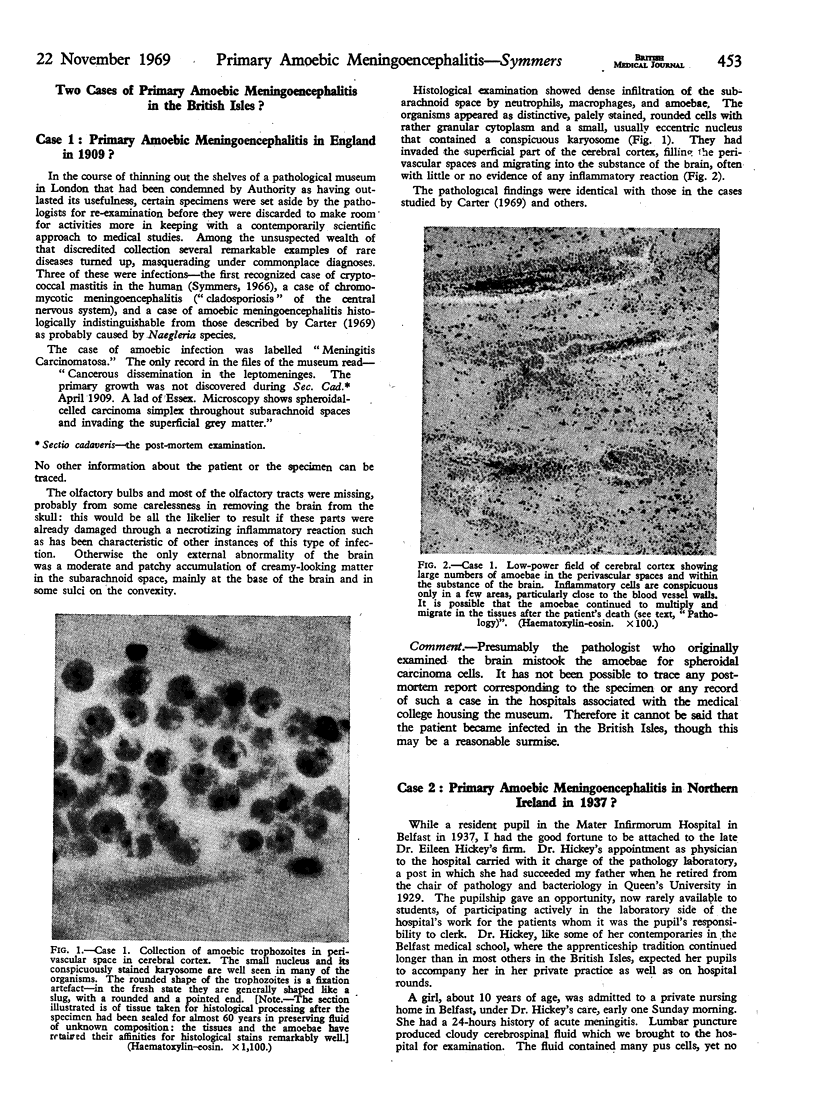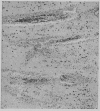Abstract
Primary amoebic meningoencephalitis is caused by amoebae of the genera Naegleria and Hartmannella (Acanthamoeba), which ordinarily are free-living saprophytes. The infection may be acquired from fresh water—for example, while bathing—the amoebae invading the nasal mucosa and reaching the meninges and brain along the olfactory nerve filaments. The disease is designated “primary” to distinguish it from meningocerebral infection caused by the parasitic amoebae, particularly Entamoeba histolytica, which invade the central nervous system only as a result of dissemination in the blood stream from lesions in other parts of the body.
During histological reappraisal of old specimens in a medical museum in London an instance of amoebic meningoencephalitis histologically indistinguishable from the published cases has been found. The specimen dates from 1909. The patient was said to be from Essex. What may have been another case, seen in Northern Ireland in 1937, is also described briefly. These observations may indicate that this disease occurs in the British Isles.
Primary amoebic meningoencephalitis should be considered in the differential diagnosis of every case of acute meningitis.
Full text
PDF





Images in this article
Selected References
These references are in PubMed. This may not be the complete list of references from this article.
- Armstrong J. A., Pereira M. S. Identification of "Ryan Virus" as an amoeba of the genus Hartmannella. Br Med J. 1967 Jan 28;1(5534):212–214. doi: 10.1136/bmj.1.5534.212. [DOI] [PMC free article] [PubMed] [Google Scholar]
- Butt C. G., Baro C., Knorr R. W. Naegleria (sp.) identified in amebic encephalitis. Am J Clin Pathol. 1968 Nov;50(5):568–574. doi: 10.1093/ajcp/50.5.568. [DOI] [PubMed] [Google Scholar]
- CULBERTSON C. G., HOLMES D. H., OVERTON W. M. HARTMANELLA CASTELLANI (ACANTHAMOEBA SP): PRELIMINARY REPORT ON EXPERIMENTAL CHEMOTHERAPY. Am J Clin Pathol. 1965 Apr;43:361–364. doi: 10.1093/ajcp/43.4.361. [DOI] [PubMed] [Google Scholar]
- CULBERTSON C. G. Pathogenic Acanthamoeba (Hartmanella). Am J Clin Pathol. 1961 Mar;35:195–202. doi: 10.1093/ajcp/35.3.195. [DOI] [PubMed] [Google Scholar]
- CULBERTSON C. G., SMITH J. W., COHEN H. K., MINNER J. R. Experimental infection of mice and monkeys by Acanthamoeba. Am J Pathol. 1959 Jan-Feb;35(1):185–197. [PMC free article] [PubMed] [Google Scholar]
- CULBERTSON C. G., SMITH J. W., MINNER J. R. Acanthamoeba: observations on animal pathogenicity. Science. 1958 Jun 27;127(3313):1506–1506. doi: 10.1126/science.127.3313.1506. [DOI] [PubMed] [Google Scholar]
- Cerva L., Novák K., Culbertson C. G. An outbreak of acute, fatal amebic meningoencephalitis. Am J Epidemiol. 1968 Nov;88(3):436–444. doi: 10.1093/oxfordjournals.aje.a120905. [DOI] [PubMed] [Google Scholar]
- Cerva L., Novăk K. Amoebic meningoencephalitis: 16 fatalities. Science. 1968 Apr 5;160(3823):92–92. doi: 10.1126/science.160.3823.92. [DOI] [PubMed] [Google Scholar]
- Culbertson C. G., Ensminger P. W., Overton W. M. Hartmannella (acanthamoeba). Experimental chronic, granulomatous brain infections produced by new isolates of low virulence. Am J Clin Pathol. 1966 Sep;46(3):305–314. doi: 10.1093/ajcp/46.3.305. [DOI] [PubMed] [Google Scholar]
- Culbertson C. G., Ensminger P. W., Overton W. M. Pathogenic Naegleria sp.--study of a strain isolated from human cerebrospinal fluid. J Protozool. 1968 May;15(2):353–363. doi: 10.1111/j.1550-7408.1968.tb02136.x. [DOI] [PubMed] [Google Scholar]
- Fowler M., Carter R. F. Acute pyogenic meningitis probably due to Acanthamoeba sp.: a preliminary report. Br Med J. 1965 Sep 25;2(5464):740–742. doi: 10.1136/bmj.2.5464.734-a. [DOI] [PMC free article] [PubMed] [Google Scholar]
- JAHNES W. G., FULLMER H. M. Free living amoebae as contaminants in monkey kidney tissue culture. Proc Soc Exp Biol Med. 1957 Nov;96(2):484–488. doi: 10.3181/00379727-96-23515. [DOI] [PubMed] [Google Scholar]
- KERNOHAN J. W., MAGATH T. B., SCHLOSS G. T. Granuloma of brain probably due to Endolimax williamsi (Iodamoeba butschlii). Arch Pathol. 1960 Nov;70:576–580. [PubMed] [Google Scholar]
- LOMBARDO L., ALONSO P., SAENZARROYO L., BRANDT H., HUMBERTOMATEOS J. CEREBRAL AMEBIASIS: REPORT OF 17 CASES. J Neurosurg. 1964 Aug;21:704–709. doi: 10.3171/jns.1964.21.8.0704. [DOI] [PubMed] [Google Scholar]
- Patras D., Andujar J. J. Meningoencephalitis due to Hartmannella (Acanthamoeba). Am J Clin Pathol. 1966 Aug;46(2):226–233. [PubMed] [Google Scholar]
- SYMMERS W. S. OPPORTUNISTIC INFECTIONS. THE CONCEPT OF 'OPPORTUNISTIC INFECTIONS'. Proc R Soc Med. 1965 May;58:341–346. [PMC free article] [PubMed] [Google Scholar]




